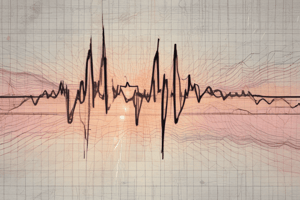Podcast
Questions and Answers
Which wave represents the final rapid phase of ventricular repolarization?
Which wave represents the final rapid phase of ventricular repolarization?
- P wave
- ST segment
- QRS complex
- T wave (correct)
What does the QT interval represent?
What does the QT interval represent?
- Duration of atrial systole
- Duration of ventricular systole
- Duration of ventricular repolarization
- Duration of ventricular contraction (correct)
Which part of the ECG represents atrial depolarization?
Which part of the ECG represents atrial depolarization?
- QRS complex
- ST segment
- P wave (correct)
- T wave
What does the PR interval measure?
What does the PR interval measure?
How many separate sensors (leads) does a standard ECG have?
How many separate sensors (leads) does a standard ECG have?
Which leads are recorded using arm and leg sensors?
Which leads are recorded using arm and leg sensors?
What type of leads are bipolar and consist of a pair of electrodes?
What type of leads are bipolar and consist of a pair of electrodes?
Which device provides a continuous readout of cardiac activity often with assessment of a patient's condition?
Which device provides a continuous readout of cardiac activity often with assessment of a patient's condition?
What is the purpose of an ECG machine?
What is the purpose of an ECG machine?
What is the SA node responsible for?
What is the SA node responsible for?
What is the term for the process in which heart cells change from a polarized state to a depolarized state?
What is the term for the process in which heart cells change from a polarized state to a depolarized state?
How many leads does a 12-lead ECG have?
How many leads does a 12-lead ECG have?
What is the purpose of the exercises mentioned in the objectives?
What is the purpose of the exercises mentioned in the objectives?
Who developed the ECG?
Who developed the ECG?
Which wave on the ECG represents ventricular depolarization?
Which wave on the ECG represents ventricular depolarization?
What is the general direction of heart depolarization?
What is the general direction of heart depolarization?
What is the purpose of the 0.1 second delay at the AV node?
What is the purpose of the 0.1 second delay at the AV node?
Which wave on the ECG represents atrial depolarization?
Which wave on the ECG represents atrial depolarization?
What is the significance of ST segment elevation or depression on the ECG?
What is the significance of ST segment elevation or depression on the ECG?
What is the purpose of the precordial sensors (leads) on the patient's chest wall?
What is the purpose of the precordial sensors (leads) on the patient's chest wall?
What does the QRS complex represent on the ECG?
What does the QRS complex represent on the ECG?
Which leads provide a view of the interventricular septum?
Which leads provide a view of the interventricular septum?
What is the significance of the positive sensor in limb leads?
What is the significance of the positive sensor in limb leads?
Which leads look at the inferior aspect of the heart's electrical activity?
Which leads look at the inferior aspect of the heart's electrical activity?
What is the purpose of augmented limb leads in ECG recordings?
What is the purpose of augmented limb leads in ECG recordings?
What is the angle at which augmented limb leads intersect?
What is the angle at which augmented limb leads intersect?
Which leads provide a view of the anterior wall of the left ventricle?
Which leads provide a view of the anterior wall of the left ventricle?
Why does the R wave grow taller and the S wave disappear from V1 to V6?
Why does the R wave grow taller and the S wave disappear from V1 to V6?
What is the purpose of having multiple limb leads in ECG recordings?
What is the purpose of having multiple limb leads in ECG recordings?
What do the chest (precordial) leads primarily observe in the heart?
What do the chest (precordial) leads primarily observe in the heart?
Flashcards are hidden until you start studying
Study Notes
ECG Basics
- ECG represents the electrical activity of the heart.
- A standard ECG has 12 separate sensors (leads).
Leads and Their Functions
- Bipolar leads consist of a pair of electrodes.
- Augmented limb leads (aVL, aVR, aVF) provide a view of the interventricular septum.
- Chest (precordial) leads (V1-V6) primarily observe the anterior wall of the left ventricle.
- Leads II, III, and aVF look at the inferior aspect of the heart's electrical activity.
Waves and Intervals
- The P wave represents atrial depolarization.
- The QRS complex represents ventricular depolarization.
- The QT interval represents the duration of ventricular depolarization and repolarization.
- The PR interval measures the time between atrial depolarization and ventricular depolarization.
Cardiac Function and ECG
- The SA node is responsible for initiating the heartbeat.
- Depolarization is the process by which heart cells change from a polarized state to a depolarized state.
- The 0.1 second delay at the AV node allows for atrial contraction to finish before ventricular contraction.
ECG Analysis
- ST segment elevation or depression on the ECG indicates myocardial injury or ischemia.
- The R wave grows taller and the S wave disappears from V1 to V6 due to the change in orientation of the heart's electrical activity.
ECG History and Purpose
- The ECG was developed by Willem Einthoven.
- The purpose of an ECG machine is to provide a continuous readout of cardiac activity and assess a patient's condition.
Studying That Suits You
Use AI to generate personalized quizzes and flashcards to suit your learning preferences.




